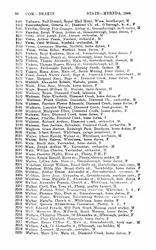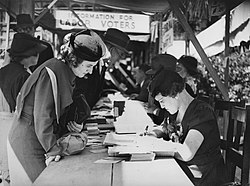
Electoral rolls are lists of names and addresses of eligible voters in different electoral districts; these help election officials at polling places to be able to keep track of who and how many people have voted in any particular election.
The electoral roll, depending on the country, can be also called the electoral register, voter list, or poll book. The electoral rolls also help with the detection of voter fraud, as the appropriate authorities use them to check the identities of voters and make sure that names have not been marked more than once; they are able also to see who hasn't voted and, if applicable, issue fines. Australia has one of the highest electoral turnout rates among the OECD countries;[1] first-time offenders are issued a fine of AU$20, and a maximum penalty can reach up to the amount of AU$180, which is generally enforced.[2]
Research your ancestors on MyHeritage
History of Australian electoral rolls and voting

In 1842 a small group of male settlers were given the right to vote, however, they were only eligible to elect a proportion of the Colony's Legislative Council. Voting was restricted to men of age 21 and older, who owned or leased property of at least a certain value.[3] In 1855,[4] after the Eureka Rebellion, a series of events involving gold miners who revolted against the British administration of the colony of Victoria, the right to vote, amongst other demands, was granted.
The "Australian Ballot", otherwise known as the secret ballot, was implemented during the 1850s. This was to ensure elections were held fairly; before this was implemented, people voted publicly, which left them vulnerable to attacks, intimidation and coercion. In 1894, South Australia was the first state/territory to allow women in an election.[5] The first Federal election in Australia took place in 1901.[3]
Information found in Australian electoral rolls
The Australian electoral rolls contain a number of fields that are very useful for family research:[6]
- Name
- Address
- Occupation (omitted after 1983)
- Gender
Importance of electoral rolls for family history
Electoral rolls can be of great value to family historians and other researchers as they help to locate the residential address of a known person in a particular year or over a period of years as well as changes of address over time, and they can also help identify other adult family members living at the same address. In this way, they can be used as a substitute or complement for census records.[7]
See also
Explore more about Australian electoral rolls
- Australia Electoral Rolls, 1893-1949 at MyHeritage
- Bendigo Electoral Roll 1922 at MyHeritage
- Queensland State Electoral Roll 1895 at MyHeritage
- Tasmania, Australia, Electoral Rolls 1916 at MyHeritage
- Queensland, Australia, Electoral Rolls 1959 at MyHeritage
- Queensland, Australia, Electoral Rolls 1941 at MyHeritage
- Queensland, Australia, Electoral Rolls 1949 at MyHeritage
- Queensland, Australia, Electoral Rolls 1934 at MyHeritage
- Queensland, Australia, Electoral Rolls 1922 at MyHeritage
- Queensland, Australia, Electoral Rolls 1913 at MyHeritage
- Queensland, Australia, Electoral Rolls 1906 at MyHeritage
- Queensland, Australia, Electoral Rolls 1903 at MyHeritage
- Queensland State Electoral Roll 1900 at MyHeritage
- Australian Census Substitutes at Legacy Family Tree Webinars
- Australian voting history in action at Australian Electoral Commission
- Commonwealth Electoral Rolls for family history at the National Library of Australia
- Australian electoral rolls at the National Library of Australia
References
- ↑ Will Other Countries Continue to Outpace the U.S. in Voter Turnout? U.S. News & World Report
- ↑ Fines and court: What can happen if you don't vote. ABC News Australia
- ↑ 3.0 3.1 Electoral Rolls: History of Voting Eligibility. State Library of South Australia
- ↑ Victoria Constitution Act 1855 (UK)
- ↑ 1894: Women’s suffrage, South Australia. National Museum of Australia
- ↑ Australian electoral rolls. National Library of Australia
- ↑ National Library of Australia


